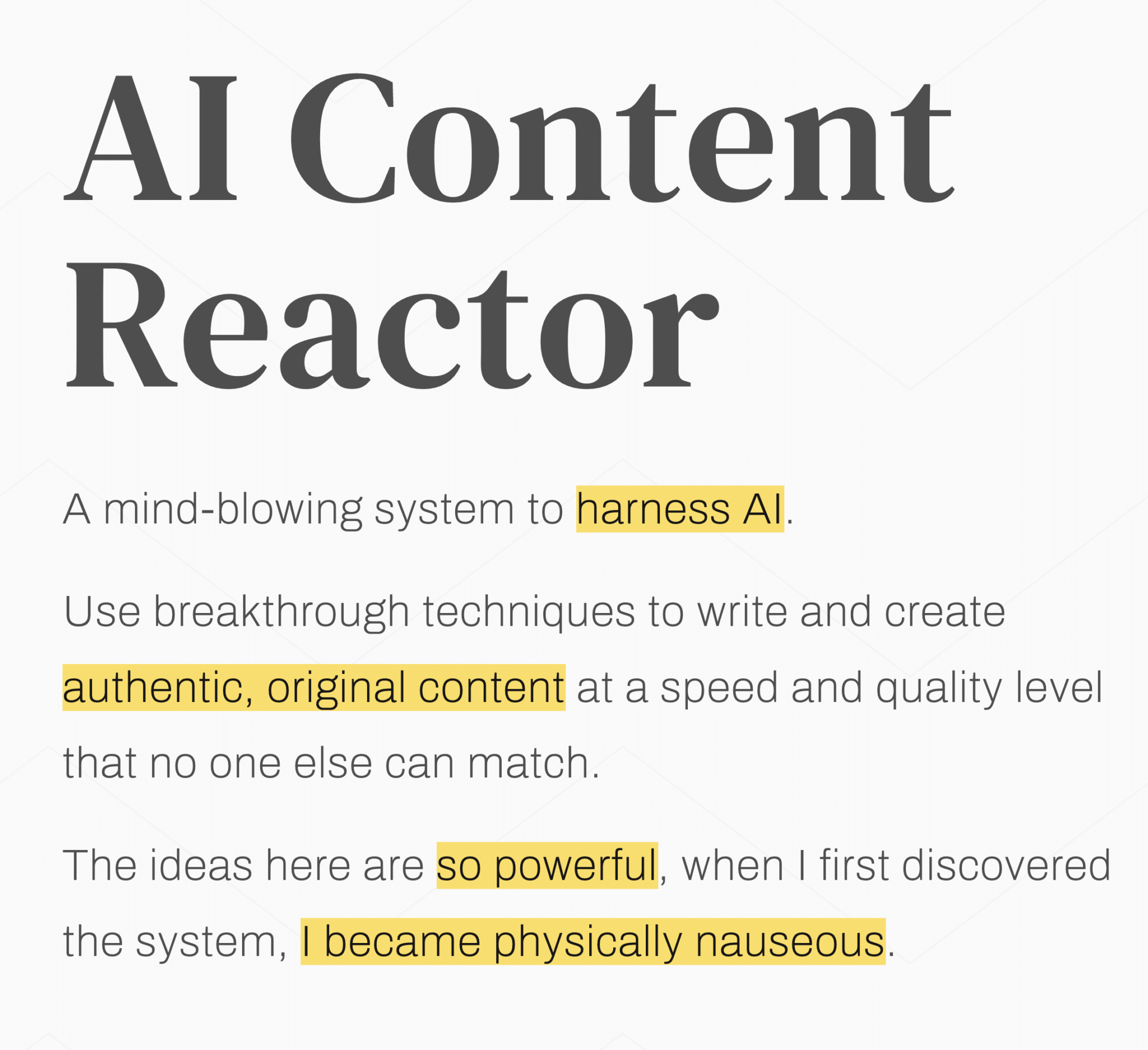Repurposing content: to adapt content for use in a different purpose. Publisher: an individual or corporation responsible for the printing and distribution of digital or printed publications. In other words, you.
Has it ever seemed like a waste of time, putting in all those endless hours creating this blog post or that blog post, only to get the initial burst of visits that trails off after a week? Doesn’t it sometimes feel like the post wasn’t worth the time you put into it? –Or maybe you’re surprised that it didn’t do as well as you thought it would. Has it ever occurred to you that maybe it was a good piece, but you just didn’t put it in the right medium?
Consistently developing fresh content is difficult. It just is. However, if repurposing content becomes part of your content strategy, “fresh” becomes relative to the medium you’re using. For example, last week’s blog post is old new – unless you turn it into this week’s brand new SlideShare. Bam – fresh content for the SlideShare community.
Reusing existing content – aka “repurposing content,” as the marketing community calls it – has several purposes, and there are many ways to accomplish it.
How to max out the usefulness of this guide:
As you read through this guide, remember your own situation. Have a notepad and pen next to you, and write down any ideas that come to mind that you might be about to use on your own site. Don’t worry about whether they’re viable options now; you can figure that out later. This a “free thinking” exercise.
Ready?
Let’s begin.
In this Guide:
- Developing Content: #thestruggleisreal
- 3 Types of Repurposed Content
- 4 Business Benefits of Repurposing Content
- 12 Ways to Repurpose Content
- Repurposing Tools
- What Not to Do When Repurposing Content

Developing Content: #thestruggleisreal
Content: it’s the ultimate, valuable, online commodity small and large businesses use to gain audiences, build brand awareness and increase sales or memberships. You can only develop content with time or money.
Whichever resource you use, whether your sweat equity or your cash flow, it can strain the company. Yet, content development is a critical marketing tool, so the resources have to be expended.
Despite the fact that the content is hard won, many fail to maximize its potential. By learning to reuse ideas and concepts from content that already exists, you can learn to leverage the full potential of each one.

‘3 Types of Repurposed Content
Overall, there are three ways publishers can reuse content. They are:
Content aggregation: a publisher collects content based on a specific topic, normally using an automated tool, and then disperses it to an audience. This is not, necessarily, your own content.
In most examples, there is no quality control with this method; the content simply contains keywords related to the subject and may — or may — not provide value to readers. However, there are some good content aggregation sites. Examples include AllTop, and Blogengage.
If you decide to use content aggregation, Mequoda has a good list of aggregation guidelines. Although it’s pointed to news aggregators, they’re good points to pay attention to no matter what you’re genre is.
Content curation: similar to content aggregation; however, when a publisher curates content, they take the time to cull information from credible sources and vet the information making sure their readers will benefit from the content.
Again, this is not necessarily your own content. It is, however, a strong method to build up your reputation as an industry leader. Examples include Scoop.it, which we’re still using and enjoying today, and CMO.
Content repurposing: the art of taking one form of content and turning it into another form of content. For instance, you can use an evergreen blog post and create a video blog — known as a vlog — with the material. In a digital world, where there is an expert for almost any subject, this technique can help you develop content without struggling to come up with new ideas and concepts.
4 Business Benefits of Repurposing Content
Why should you bother repurposing content? What’s the real business benefit? In addition to helping you formulate ideas, content repurposing can serve several other functions:
- Reach a wider audience. Repurposing content can allow you to reach audience members who may not, or cannot, consume information in the format it was originally published. For instance, a traveling salesperson who spends hours driving can easily listen to a podcast on the road versus reading a text blog that requires them to dedicate complete focus on the task.
- Reach a more diverse audience. Some people absorb information best by reading it. Blog posts, whitepapers and the like are excellent resources for these individuals. Others, on the other hand, need images to fully understand a concept.
- Revisit important information without seeming repetitive. Repurposing content is a valuable tool to revisit relevant information you have previously communicated. You can portray the information to others who may not have consumed it or provide a refresher to consumers who have.
- Boost your SEO efforts. By repurposing content, you’re creating several pieces around the same topic, which increases your relevance for target key terms. As an additional benefit, you get targeting anchor text when you post your repurposed pieces off site.

12 Ways to Repurpose Content
To recap, repurposing content is using previously created content for another purpose. There are many ways you can accomplish this. Let’s start from the top.
We’re going to use a fictional article entitled “7 Ways to Screw Up Your Content” as our example article. It’s listicle – an article in the form of a list. How can we repurpose this?
- Create seven new articles. Each article covers a single point from our original piece, and does so in depth.
- Turn all eight articles (the original and the new seven) into a single whitepaper.
- Turn the original article into a PowerPoint presentation.
- Turn the PowerPoint Presentation into a YouTube video. (The hardest part of this is the edits. We’ve done a few YouTube videos and, although they were successful, they took a lot more time in edits than we first expected.)
- Interview a few industry experts/peers about their own experiences – refer back to the original post. Turn this into a blog post.
- Turn the interviews into an expert advice eBook with the whitepaper content and interviews.
- Turn the PowerPoint into an infographic.
- Turn the infographic into an instructographic.
- Turn the points from the original article into timed Twitter tweets.
- Turn the original article into a daily email series using the 7 points – use parts of the other seven articles to beef up each email.
- Hire someone to do a podcast of the eight articles (or do your own eight-day podcast).
- Address comments and questions that arise from all of the above in another follow-up article.
The Outcome
By the time it’s all said and done, if we followed this list from beginning to end, we’d have:
- 10 articles
- a whitepaper
- a PowerPoint presentation
- a YouTube video
- an infograph
- an instructographic
- an eBook
- at least 8 scheduled Twitter tweets
- a podcast
- an 8-day email series
That’s a lot of focused collateral, all stemming from a single piece of content.

Repurposing Tools
There are many tools that help to repurpose content, but here are a few that we particularly like.
1. Video Repurposing Tools
- quso.ai
- Best for: All-in-one solution with multiple tools
- Features: Converting long-form videos into short clips, brand kits, social media templates, AI captions, marketing copy generation
- Price: Plans from $0 to $49/mo
- Lumen5
- Best for: Converting blog posts to videos
- Features: Extensive media library, drag-and-drop editor, automated captioning
- Price: Free plan available; paid plans from $29+/mo
2. Audio/Podcast Repurposing Tools
- Wavve
- Best for: Converting audio content to social media videos
- Features: Automated transcription, captions, animations
- Price: $19.99/month unlimited plan
- Descript
- Best for: Audio/video editing and repurposing via text edits
- Features: Text-based editing, transcription, clip creation
- Price: Free plan available; paid plans from $12-$40/mo
3. Written Content Repurposing Tools
- Designrr
- Best for: Converting existing blog posts, podcasts, videos and PDFs into eBooks,show notes, dynamic flipbooks, transcripts, PDFs and web pages
- Features: Multi-source integration, template library, automated formatting
- Price: $29-$99/mo
- Repurpose.io
- Best for: Cross-platform content distribution. Repurpose content directly from TikTok, Instagram, YouTube, Facebook, Zoom, Google Drive, Dropbox, and audio podcasts into unlimited pieces of content optimized for each platform.
- Features: Automated posting, format conversion, scheduling
- Price: $35/month
4. Other Repurposing Tools
- MeetEdgar
- Best for: Social media content scheduling automation
- Features: Content library, automated scheduling, variation creation
- Price: Starting at $29.99/month
- Canva
- Best for: Visual content repurposing
- Features: Magic Switch tool, Brand Kit, templates
- Price: Free plan available; Pro from $15/mo
- Piktochart
- Best for: Infographic creation
- Features: Templates, drag-and-drop editor
- Price: From $0 – $49/mo
What Not to Do When Repurposing Content
Do not misconstrue repurposing as republishing unchanged content. If you do this, a significant segment of your reader or viewership will stop consuming the piece as soon as they recognize it. This includes publishing the same content across different platforms.
For instance, it’s highly shunned upon for a publisher to post the same article on their WordPress blog and their Facebook page. This practice can alienate your best followers. Repurposing content means to use existing content and make it new by rewriting it with a fresh angle and updated information that benefits even a returning reader or viewer. A consumer won’t mind absorbing information on the same topic as long as they feel they’re learning something new. Keep this in mind as you repurpose your content.
There is virtually no limit to how you can repurpose content, as you can see from the above. You can change the content medium or simply use the content for inspiration for another piece.
As a publisher, creating new content is challenging. Content repurposing helps you fully capitalize on the impact of your writing and concepts. Many publishers repurpose content created by themselves or others to overcome this obstacle. By practicing content repurposing you can reach varied audiences, converting content from one format to another, and get the most out of your resources.




































